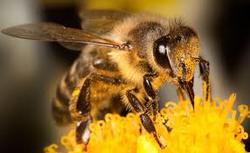
Controlling Bees and Wasps
Both bees and wasps can be beneficial to the natural environment. Wasps are predators, helping to control other insects. Bees pollinate plants and produce honey and wax. That doesn’t mean they should be invited to share our living spaces.
Paper wasps commonly build paper-like nests under the eaves of homes, businesses or other structures. Bees typically build their colonies once they have found their way inside an open cavity, preferably a hollow tree, but sometimes a wall, attic or unprotected chimney. Preventing bees or wasps from taking up residence means limiting access to nesting sites, food and water supply.
Caulk all holes around the exterior of the building. Use screens of less than 1/8 inch opening in weep holes or over soffit vents.
Cover outside trash cans tightly.
Remove trash frequently.
Fill in low spots where water pools after it rains.
If you find evidence that bees or wasps are living on or in your building, the best thing to do is to call a licensed professional. In the case of honey bees, extermination is not the end of the story. The hive must be located, the honeycomb removed and repairs made to seal the area completely or another colony may move in on top of the old one.
Both bees and wasps can be beneficial to the natural environment. Wasps are predators, helping to control other insects. Bees pollinate plants and produce honey and wax. That doesn’t mean they should be invited to share our living spaces.
Paper wasps commonly build paper-like nests under the eaves of homes, businesses or other structures. Bees typically build their colonies once they have found their way inside an open cavity, preferably a hollow tree, but sometimes a wall, attic or unprotected chimney. Preventing bees or wasps from taking up residence means limiting access to nesting sites, food and water supply.
Caulk all holes around the exterior of the building. Use screens of less than 1/8 inch opening in weep holes or over soffit vents.
Cover outside trash cans tightly.
Remove trash frequently.
Fill in low spots where water pools after it rains.
If you find evidence that bees or wasps are living on or in your building, the best thing to do is to call a licensed professional. In the case of honey bees, extermination is not the end of the story. The hive must be located, the honeycomb removed and repairs made to seal the area completely or another colony may move in on top of the old one.

 RSS Feed
RSS Feed